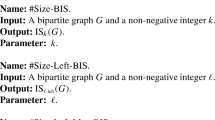Abstract
Counting and enumerating maximal and maximum independent sets are well-studied problems in graph theory. In this paper we introduce methods to count and enumerate maximal/maximum independent sets in threshold graphs and k-threshold graphs and improve former results for these problems. The results can be applied to combinatorial optimization problems, and in particular to different variations of the knapsack problem. As feasible solutions for instances of those problems correspond to independent sets in threshold graphs and k-threshold graphs, we obtain polynomial time results for special knapsack and multidimensional knapsack instances. Also, we show lower and upper bounds for the number of necessary bins in several bin packing problems.
Similar content being viewed by others
Notes
The class of \(\#\text{ P }\)-complete problems is a class of computationally equivalent counting problems which are at least as difficult as NP-complete problems.
A graph G with n vertices and m edges is \(\ell \)-sparse if \(m \le \ell \cdot n\). It is uniformly \(\ell \)-sparse if every subgraph of G is \(\ell \)-sparse.
For \(A=A'=\{a_1,a_2\}\), \(s_1=2\), \(s_2=7\), \(c=10\), the right condition is true, but for \(j=j'=2\) the left condition is not true.
Because of the hardness result in Yannakakis (1982), we assume that we are given k threshold graphs which cover the edge set of G.
Please note the different but equivalent definition of edges within threshold graphs in Caprara et al. (2004). By using values \(w_i\) for the vertices \(v_i\) such that \(0<w_i\le 1\), the authors in Caprara et al. (2004) define edges \(\{v_i,v_j\}\) whenever \(w_i+w_j\le 1\). For our notation see the statement (3.) of Theorem 3.
References
Brandstädt A (1996) Partitions of graphs into one or two independent sets and cliques. Discrete Math 152:47–54
Caprara A, Lodi A, Rizzi R (2004) On $d$-threshold graphs and $d$-dimensional bin packing. Networks 44(4):266–280
Chvátal V, Hammer PL (1973) Set-packing and threshold graphs. In: Technical report CORR 73–21. Computer Science Department, University of Waterloo
Chvátal V, Hammer PL (1977) Aggregation of inequalities in integer programming. Ann Discrete Math 1:145–162
D’Ambrosio C, Furini F, Monaci M, Traversi E (2018) On the product knapsack problem. Optim Lett 12(4):691–712
Fréville A (2004) The multidimensional 0–1 knapsack problem: an overview. Eur J Oper Res 155:1–21
Golumbic MC (1980) Algorithmic graph theory and perfect graphs. Academic Press, Cambridge
Gurski F, Rehs C (2018) A graph theoretic approach to solve special knapsack problems in polynomial time. In: Operations research proceedings (OR 2017), selected papers. Springer, pp 295–301
Gurski F, Rehs C (2019) The knapsack problem with conflict graphs and forcing graphs of bounded clique-width. In: Operations research proceedings (OR 2018), selected papers. Springer, pp 259–265
Gurski F, Rehs C (2019) Solutions for the knapsack problem with conflict and forcing graphs of bounded clique-width. Math Methods Oper Res 89(3):411–432
Gurski F, Rehs C, Rethmann J (2019) Knapsack problems: a parameterized point of view. Theor Comput Sci 775:93–108
Hammer PL, Simeone B (1981) The splittance of a graph. Combinatorica 1(3):275–284
Heggernes P, Kratsch D (2007) Linear-time certifying recognition algorithms and forbidden induced subgraphs. Nord J Comput 14(1–2):87–108
Leung JY-T (1984) Fast algorithms for generating all maximal independent sets of interval, circular-arc and chordal graphs. J Algorithms 5(1):22–35
Mahadev NVR, Peled UN (1995) Threshold graphs and related topics. In: Annals of discrete mathematics, vol 56. Elsevier, North-Holland
Moon J, Moser L (1965) On cliques in graphs. Isr J Math 3:23–28
Okamoto Y, Uno T, Uehara R (2008) Counting the number of independent sets in chordal graphs. J Discrete Algorithms 6(2):229–242
Ortiz ZC, Villanueva-Ilufi M (2004) Difficult problems in threshold graphs. Electron Notes Discrete Math 18:187–192
Paull M, Unger S (1959) Minimizing the number of states in incompletely specified state machines. IRE Trans Electron Comput EC–8:356–367
Pferschy U, Schauer J (2009) The knapsack problem with conflict graphs. J Graph Algorithms Appl 13(2):233–249
Pferschy U, Schauer J (2017) Approximation of knapsack problems with conflict and forcing graphs. J Comb Optim 33(4):1300–1323
Rival I (ed) (1985) Graphs and order: the role of graphs in the theory of ordered sets and its applications. In: Nato science series C: (Book 147). Springer
Tsukiyama S, Ide M, Ariyoshi H, Shirakawa I (1977) A new algorithm for generating all the maximal independent sets. SIAM J Comput 6(3):505–517
Vadhan SP (2001) The complexity of counting in sparse, regular, and planar graphs. SIAM J Comput 31(2):398–427
Yannakakis M (1982) The complexity of the partial order dimension problem. SIAM J Algebraic Methods 3(3):351–358
Acknowledgements
This work was funded in part by the Deutsche Forschungsgemeinschaft (DFG, German Research Foundation)—388221852.
Author information
Authors and Affiliations
Corresponding author
Additional information
Publisher's Note
Springer Nature remains neutral with regard to jurisdictional claims in published maps and institutional affiliations.
A short version of this paper appeared in the Proceedings of the International Conference on Operations Research (OR 2017), see Gurski and Rehs (2018).
Rights and permissions
About this article
Cite this article
Gurski, F., Rehs, C. Counting and enumerating independent sets with applications to combinatorial optimization problems. Math Meth Oper Res 91, 439–463 (2020). https://doi.org/10.1007/s00186-019-00696-4
Received:
Revised:
Published:
Issue Date:
DOI: https://doi.org/10.1007/s00186-019-00696-4




